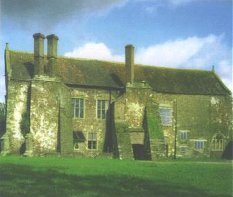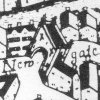A House Fit For a King
The Poyntz family made Acton Court palatial enough to please a monarch. That splendour faded and was almost forgotten, but today you can see the 16th-century state apartments with their fine painted friezes restored.
 There was already a moated manor house at Iron Acton, north of
Bristol, when the Poyntzes arrived there. It had been built by a knightly
family who took their name from the place - the Actons. But they died out in
the male line. The last Sir John of Acton married no less than four times, and
kept a mistress, without managing to produce a surviving child. So his heir in
1362 was his nephew Sir John Poyntz.
There was already a moated manor house at Iron Acton, north of
Bristol, when the Poyntzes arrived there. It had been built by a knightly
family who took their name from the place - the Actons. But they died out in
the male line. The last Sir John of Acton married no less than four times, and
kept a mistress, without managing to produce a surviving child. So his heir in
1362 was his nephew Sir John Poyntz.
The first Poyntz lord of Iron Acton seems to have been a headstrong character, with little respect for the law. He once led a raid on Hereford prison to liberate certain parties who had been arrested. He was not above liberating a few deer from his neighbour's park either. Yet one of the posts he was expected to take on as a local landowner was Commissioner of the Peace. His descendants were rather more law-abiding, not to mention prosperous. Whereas Sir John died in debt, his energetic son and grandson improved the family fortunes. But it was a twist of fate that brought the Poyntzes into the royal circle.
Sir John's great-grandson died in the prime of life. His eldest son Robert was a minor. So Edward IV made Robert a ward of one of his royal esquires. This early link with the royal household altered the course of Robert's life. A few years later he became a king's esquire himself. Edward IV's household knights and esquires were a small, trusted group, who divided their time between the Court and their home counties, where they played an important part in enforcing royal authority.
Robert Poyntz - 'a learned and remarkable man' - won a bride who drew him even closer into the royal circle. The queen's brother, Anthony Woodville, Earl Rivers, was a leading figure at Court. His only child was Margaret, born of a much-loved mistress. She became Robert's wife.
 Royal favour brings its dangers. In 1483 Edward IV died unexpectedly and the
political climate changed dramatically. The king's young sons were imprisoned
in the Tower of London by their uncle, Richard of Gloucester, who seized the
throne. Richard traded on the unpopularity of the Woodvilles, so favoured by
Edward IV. They were his immediate targets. Earl Rivers was beheaded at
Pontefract. What a shock that must have been for his daughter and son-in-law!
No wonder that Robert threw in his lot with Henry Tudor at the battle of
Bosworth. Henry won the battle and the throne; Robert was rewarded with royal
appointments. Henry secured the Tudor dynasty by his marriage to Elizabeth of
York, eldest daughter of Edward IV and a first cousin of Lady Margaret Poyntz.
Lady Margaret's illegitimacy was no bar to royal recognition. On 23 May 1486
Henry dined with Sir Robert at Iron Acton on his way from Gloucester to
Bristol. Ten years later Henry would make another brief visit to Acton. The
Poyntzes had become a courtier family.
Royal favour brings its dangers. In 1483 Edward IV died unexpectedly and the
political climate changed dramatically. The king's young sons were imprisoned
in the Tower of London by their uncle, Richard of Gloucester, who seized the
throne. Richard traded on the unpopularity of the Woodvilles, so favoured by
Edward IV. They were his immediate targets. Earl Rivers was beheaded at
Pontefract. What a shock that must have been for his daughter and son-in-law!
No wonder that Robert threw in his lot with Henry Tudor at the battle of
Bosworth. Henry won the battle and the throne; Robert was rewarded with royal
appointments. Henry secured the Tudor dynasty by his marriage to Elizabeth of
York, eldest daughter of Edward IV and a first cousin of Lady Margaret Poyntz.
Lady Margaret's illegitimacy was no bar to royal recognition. On 23 May 1486
Henry dined with Sir Robert at Iron Acton on his way from Gloucester to
Bristol. Ten years later Henry would make another brief visit to Acton. The
Poyntzes had become a courtier family.
Robert's grandson Nicholas was determined to make Acton Court fit for another royal visit. He built an entire new east wing to accommodate Henry VIII and his entourage for just two days in 1535. It was the king's habit to progress around the country during the summer, going from one of his palaces to another, and stopping at country houses large enough to cope with a royal retinue. The itinerary was planned in advance, but Nicholas had less than a year to prepare. Yet the new wing was not only finished, but lavishly decorated in a style calculated to impress.
Today that east wing is almost all that is left of Acton Court. After the last Poyntz of Iron Acton died in 1680, the house declined in status to tenant farmhouse. Much of it was pulled down. This change of fortunes did preserve what was left. A wealthy owner might well have rebuilt the house to suit the changing tastes of later eras. Still long years of neglect brought Acton Court to a sad state of dilapidation.
This remarkable relic was rescued by English Heritage, who funded not only restoration, but a comprehensive study. Archaeologists dug the site and painstakingly recorded every inch of the building, while I dug into documents. The results were published by English Heritage - K. Rodwell and R. Bell, Acton Court: The evolution of an early Tudor courtier's house (2004).
English Heritage returned the house to private ownership on condition that it was open to the public for part of each year. To know more visit the Acton Court website

























